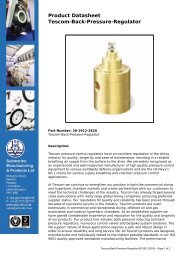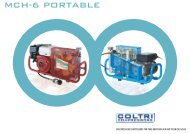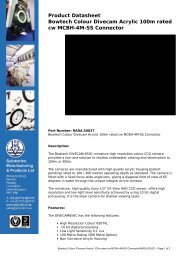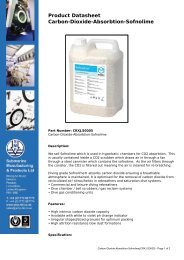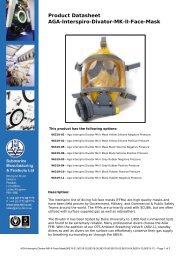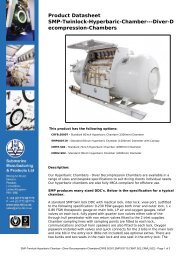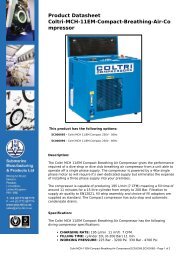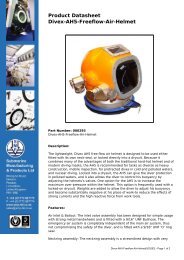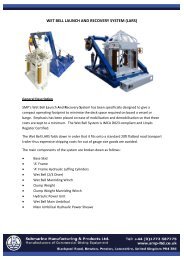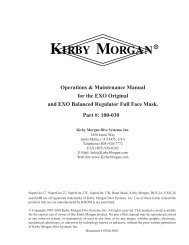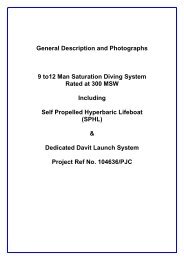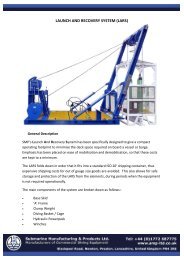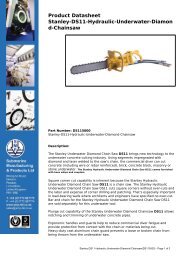Gasmizer Manual - Submarine Manufacturing and Products Ltd
Gasmizer Manual - Submarine Manufacturing and Products Ltd
Gasmizer Manual - Submarine Manufacturing and Products Ltd
Create successful ePaper yourself
Turn your PDF publications into a flip-book with our unique Google optimized e-Paper software.
March 09<br />
Oil Pump<br />
1. Remove one screw on the inside face of the unit, this will enable the rotors <strong>and</strong><br />
body to be examined for damage <strong>and</strong> wear.<br />
2. Repair by replacement of the complete unit.<br />
Re-assembly:<br />
1. Re-assemble oil bypass valve.<br />
2. Lightly oil all bearing surfaces.<br />
3. Replace centre main bearing shells <strong>and</strong> fit the housing to the crankshaft. Ensure<br />
correct mating of marked facings. Replace fitted bolts. The torque setting is 45 ft-lb<br />
(33Nm).<br />
4. Place the crankshaft in position in the crankcase.<br />
5. Replace the centre bearing locking screw making sure that it enters its location in<br />
the centre bearing. Lock down firmly in its seating. Refit the centre connection. Fit the<br />
bearing housing at the oil pump end with thrust washer correctly positioned <strong>and</strong> new<br />
paper gasket fitted at the end face. Tighten nuts, torque setting is – 24 ft-lb (17.7Nm).<br />
6. Replace the filter <strong>and</strong> plugs.<br />
7. Fill the oil pump with lubricating oil <strong>and</strong> replace couplings.<br />
8. Ensure that a serviceable gasket is available <strong>and</strong> fit the oil pump with the dive<br />
correctly engaged. Replace <strong>and</strong> tighten bolts, torque setting is 10 ft-lb (7.4 Nm).<br />
9. Reconnect Oil suction pipe.<br />
10. With the thrust washer correctly positioned fit the drive end main bearing housing.<br />
A paper gasket is used at the face joint. Tighten nuts, torque setting is – 24 ft-lb (17.7<br />
Nm). Care must be taken not to damage sealing lip of oil seal.<br />
11. Check crankshaft for freedom of rotation <strong>and</strong> also check that the maximum end<br />
float measurement does not exceed the limit given in 9.9.7. (2)e.<br />
12. Refit each connection rod, ensuring that each bearing shell is correctly fitted in its<br />
half housing with lug engaged in the recess. Tighten bolts, torque setting is 30 ft –lb<br />
(22Nm). Bend tab washers to lock nuts in position.<br />
13. Check the rods for freedom of rotation on the crankshaft.<br />
14. Replace the crankcase side covers <strong>and</strong> unloader assembly, using serviceable<br />
gaskets.<br />
15. Replace flywheel <strong>and</strong> refit key.<br />
16. Ensure that the pulleys of the drive motor <strong>and</strong> the compression are in full<br />
alignment. Fit the drive belts <strong>and</strong> adjust the belt tension as described in 9.5.4.<br />
17. Refit the oil drain plug <strong>and</strong> refill crankcase with the correct grade of lubricating oil.<br />
18. When complete booster is re-assembled re-set oil pressure, see 9.5.3.<br />
9.10 Unloaders<br />
Description:<br />
The unloaders are the solenoid controlled gas operated type. Gas supply is from<br />
booster outlet pressure reduced to 150 psi (10.3 bar) by a regulator. The solenoid is<br />
controlled by a timer, (T2). This timer is used to set the interval between unloading (0-6<br />
hrs) <strong>and</strong> the unloaded time (0-30 secs). The unloading interval should be modified as<br />
required to ensure adequate moisture removal at the booster.<br />
OM002 Rev 5 Page 118 of 168 Chap 9



